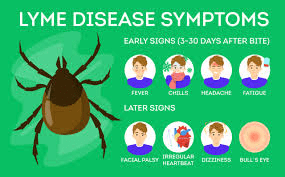
Understanding Lyme Disease Symptoms: What You Need to Know
Lyme disease is a tick-borne illness that can have a wide range of symptoms. As more people engage in outdoor activities, understanding these symptoms and the importance of early treatment has never been more critical. In this article, we will explore the various Lyme disease symptoms, how they manifest, and effective treatments available.
What is Lyme Disease?
Lyme disease is caused by the bacterium Borrelia burgdorferi, which is primarily transmitted through the bite of infected black-legged ticks, also known as deer ticks. The incidence of Lyme disease has been increasing, especially in regions where these ticks thrive. If left untreated, Lyme disease can lead to severe complications affecting the joints, heart, and nervous system.
Understanding the early signs of Lyme disease is crucial for effective treatment, so let’s delve deeper into the specific symptoms one might experience.
Common Lyme Disease Symptoms
Early Symptoms
The initial symptoms of Lyme disease often appear within 3 to 30 days after a tick bite. Some of the most common early Lyme disease symptoms include:
- Erythema migrans: One of the hallmark signs of Lyme disease is a distinctive skin rash that resembles a “bull’s-eye.” This rash appears at the site of the tick bite and expands over time, sometimes accompanied by mild itching or pain.
- Fatigue: Many individuals report feeling unusually tired or fatigued shortly after being infected. This fatigue can be overwhelming and lasts longer than typical exhaustion.
- Fever and Chills: A low-grade fever, often accompanied by chills, is a frequent symptom. It might seem like a mild flu at first.
- Headaches and Muscle Pain: Persistent headaches or generalized aches similar to those experienced during the flu can occur.
- Joint Pain: Some individuals may start to feel joint pain, particularly in the knees or other large joints.
Later Symptoms
If Lyme disease is not diagnosed and treated promptly, it can progress to later-stage symptoms, which may arise weeks to months post-infection:
- Arthritis: Severe arthritis, particularly in the knees, is a common complication. This can be debilitating and may last for years if not addressed.
- Neurological Issues: Some patients may develop neurological problems such as meningitis, radiculopathy, or facial palsy, resulting in weakness or numbness in the face.
- Cardiac Issues: Lyme carditis occurs when the infection affects the heart, leading to irregular heart rhythms or even heart block.
- Cognitive Difficulties: Known as “Lyme fog,” cognitive difficulties such as memory issues and trouble concentrating can impact daily life.
Diagnosing Lyme Disease
Diagnosing Lyme disease can be challenging due to the variance in symptoms and their overlap with other illnesses. A healthcare provider will typically diagnose Lyme disease based on:
- Medical History: Discussing any known tick exposures or outdoor activities.
- Physical Examination: Looking for the characteristic rash and other physical signs.
- Laboratory Tests: Various blood tests can help confirm the presence of antibodies against Borrelia. However, these tests may take time to yield results.
It’s essential to consult a healthcare professional if you suspect Lyme disease, especially if you’ve been in areas where ticks are prevalent.
Treatments for Lyme Disease
Timely diagnosis and treatment of Lyme disease are crucial for a full recovery. Treatment options vary depending on the stage of the disease and may include:
Antibiotics
The primary treatment for Lyme disease typically involves antibiotics. The choice of antibiotic and duration depends on the severity and stage of the disease:
- Early-Stage Lyme Disease: Oral antibiotics such as doxycycline, amoxicillin, or cefuroxime axetil are commonly prescribed for 10 to 21 days. Patients usually experience significant improvement within a few days.
- Later-Stage Lyme Disease: For individuals with persistent or more severe symptoms, such as those affecting the nervous system or joints, a longer course of antibiotics or intravenous antibiotics may be necessary.
Symptomatic Treatment
In addition to antibiotics, symptomatic treatments may be used to alleviate pain and inflammation:
- Pain Relievers: Over-the-counter (OTC) nonsteroidal anti-inflammatory drugs (NSAIDs), such as ibuprofen or naproxen, can help manage pain and swelling.
- Physical Therapy: For those with joint or neurological complications, physical therapy may be recommended to restore movement and function.
Prevention and Awareness
The best way to combat Lyme disease is prevention. Here are a few practical tips to reduce your risk:
- Avoid Tick Habitats: Stay away from dense woods and bushy areas when possible, especially during peak tick season (spring and summer).
- Dress Appropriately: Wear long sleeves, long pants, and light-colored clothing to make it easier to spot ticks.
- Use Tick Repellent: Use EPA-registered insect repellents containing DEET on exposed skin and permethrin on clothing.
- Check for Ticks Regularly: After spending time outdoors, thoroughly check yourself, pets, and gear for ticks. Remove any ticks promptly and properly.
- Maintain Your Yard: Keep grass trimmed, remove leaf litter, and create a tick-safe zone by using wood chips or gravel to reduce tick habitats in your yard.
Conclusion
Understanding Lyme disease symptoms is vital for timely treatment and recovery. From the characteristic bull’s-eye rash to more complex manifestations, recognizing these symptoms can make all the difference. If you suspect you’ve been infected, it’s essential to seek medical attention without delay. Prevention is key; by taking the necessary precautions while enjoying the great outdoors, you can help protect yourself from Lyme disease. Stay informed, stay safe, and enjoy your adventures with peace of mind!














